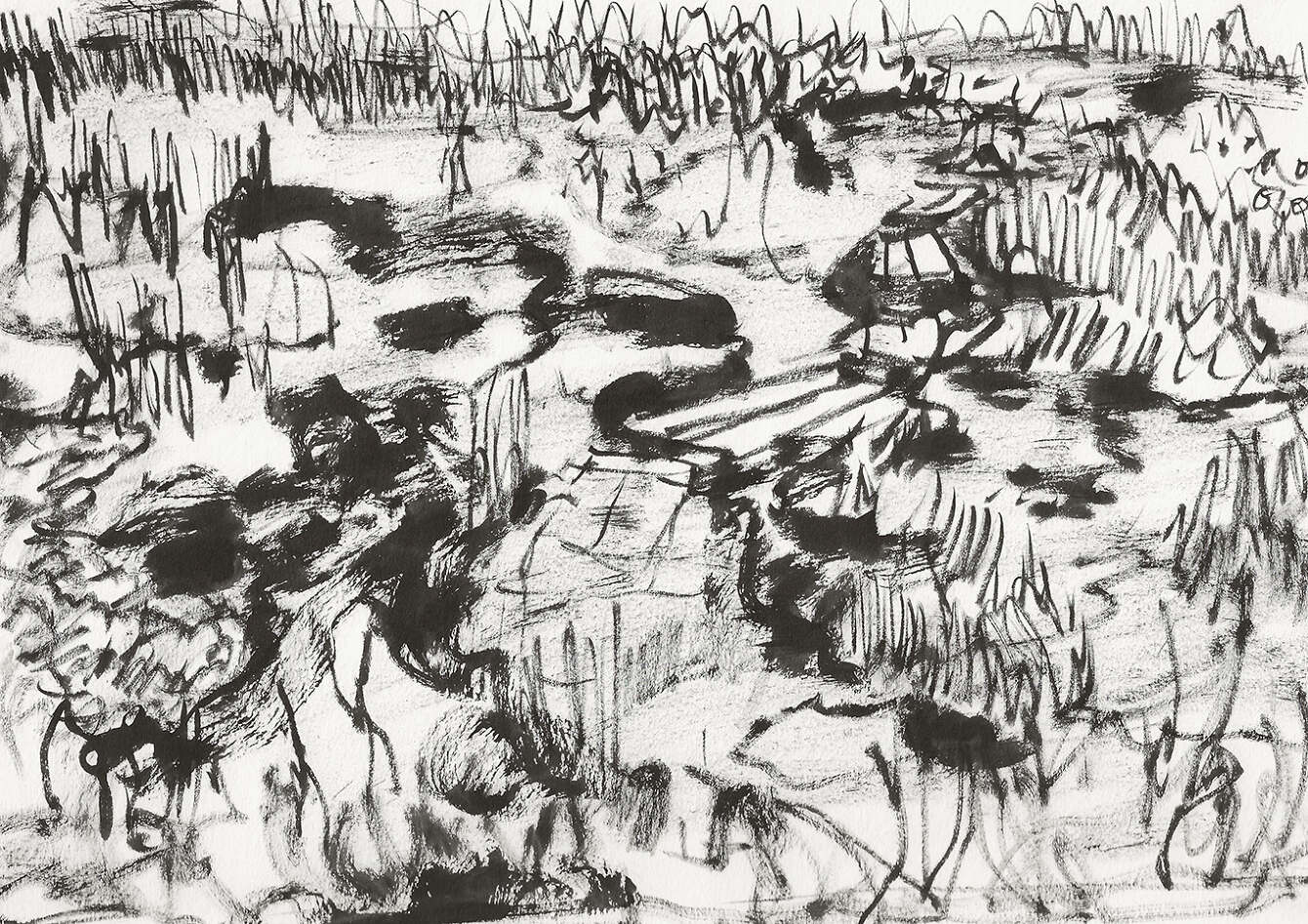Drawings of Iškoras Permafrost
 Palsa, Pond, Watergrass, Birch Forest and Iškoras, 2020, A4, Ink on Paper
Palsa, Pond, Watergrass, Birch Forest and Iškoras, 2020, A4, Ink on Paper Human Reflection, Palsa, Pond, Watergrass, 2020, A4, Ink on Paper
Human Reflection, Palsa, Pond, Watergrass, 2020, A4, Ink on Paper Birch Forest, Palsa, Pond, Watergrass, Research Site, Highlands, 2020, A4, Ink on Paper
Birch Forest, Palsa, Pond, Watergrass, Research Site, Highlands, 2020, A4, Ink on Paper Birch Forest and Shrubs, 2020, A4, Ink on Paper
Birch Forest and Shrubs, 2020, A4, Ink on Paper OTC, Palsa, Watergrass, Human, 2020, A4, Ink on Paper
OTC, Palsa, Watergrass, Human, 2020, A4, Ink on Paper Palsa, Pond, Watergrass, Boardwalk l, 2020, A4, Ink on Paper
Palsa, Pond, Watergrass, Boardwalk l, 2020, A4, Ink on Paper Palsa, Pond, Watergrass, Boardwalk ll, 2020, A4, Ink on Paper
Palsa, Pond, Watergrass, Boardwalk ll, 2020, A4, Ink on PaperThe Art & Science Research Group, was an initiative to encourage
collaboration between the Bjerknes Centre for Climate Research and
the Academy of Art and Design in Bergen. Led by artist Aleksandra Mir, it was a weekly seminar, from September till the end of our semester in December, happening every Monday roughly between 11-13.30, on Zoom. It was an intense and productive course where each participating student was paired with a researcher at the Bjerknes Centre for Climate Research.
This series of drawings were made in relation to a permafrost field trip to Finnmark September 4th -9th, 2020 with researchers Inge Althuizen and Hanna Lee. Our expedition timed the arrival of the autumn and the birch forests, stretching beyond the horizon with the view from the highland, coloured the landscape in tones of yellow and orange, leaving the furthest mountains to slumber in shades of deep violet. The research site is located on the mountain Iškoras, some 300 meters above sea-level, set just below the three line. Descending towards the site, passing through a golden forest, we arrive at the permafrost site. There are no trees here, making it an open patch in the forest. Parts of the site is covered in water, resembling eyes reflecting the clouds, the sky and the changes taking place. Most of the area is covered in watergrass, whilst the remaining mounds of permafrost, called palsa (peat mounds of decayed vegetation, hence the release of methane when thawing), is shrinking.
With these drawings, I aim to visualise the science, and the landscape relating to the thawing of permafrost. I believe documentation, in the form of drawings and painting, even abstracted, can serve as an alternative to photography, as we perceive the two art forms differently and that they – in turn –have different impacts on our imagination. Drawings and paintings allow us to enter a person´s immediate response to their surroundings as they translate it through an idiosyncratic, visual language.
Some of the drawings were made on the site, whilst others were made from footage I brought back as reference. The most important factor for me when making drawings of a certain place, in order to give its reproductions a claim to authenticity, is to have experienced the place. The experience of a spatial space gives rise to its truer if not exact, replication. There is a sense of honesty to this.
In one drawing, there are reflections of the scientists taking measurements on the palsa, the drawing has an intimacy about it, which is unachievable without memories or footage. The reflections are cast onto the surface of a pond that is expanding. In the wake of the permafrost thawing, the palsa will collapse. Researcher Inge Althuizen suggests that within this century, or the next, the site here will have transformed into a pond vegetated by watergrass, which eventually – in another thousand years or so – will have become a birch forest. The birch forest is already present, framing the outskirts of the site in a vast circle. Imagining its approach is a haunting vision of the abrupt transition the climate emergency is enforcing upon this landscape.
Some of the drawings show scientific equipment such as the OTC (open top chamber), which is a simple and cost-effective construction. In this research project, it has been used to measure the effect of 2 degrees warming on an artificial climate (inside the OTC).
Capturing the rhythm of this vast undulating landscape – and the presence of the patch of permafrost within it – is a work in progress. Where the permafrost thawing is deep the palsa tears, and submerges into the pond. It feels more accurate to say the ground is tearing rather than cracking or breaking, palsa is composed of decaying vegetation and comes apart like fresh bread or cake.
There is a fractured nature to the drawings, they are thorn and unpredictable yet calm and composed. The permafrost site holds much uncertainty, a melancholy and a perseverance despite its bleak prognosis. If anything, painting and drawing give way for a more imaginative and empathetic understanding of urgent changes in nature and the science accompanying our understanding of it. They represent, in the end, universal feelings and sensations related to life.
Unn, September, 2020